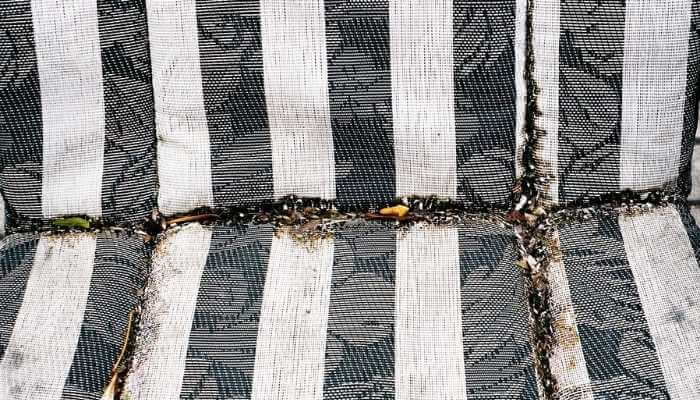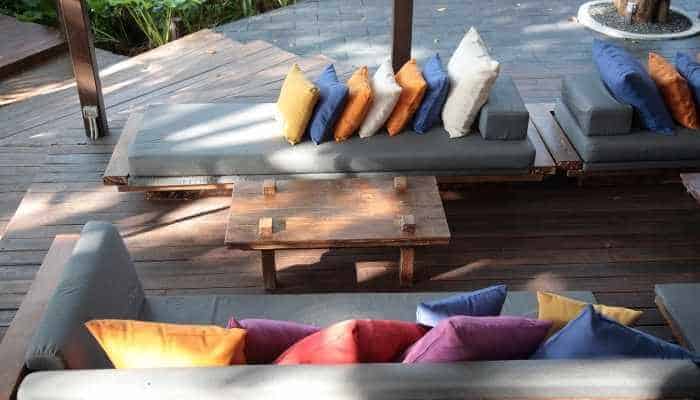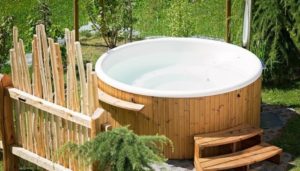When we’re talking about the heavy-duty, composite outdoor plastic furniture that will last decades, know that this furniture is nearly maintenance-free. But there is a need to clean it. It can get dirty, stained, scratched, and even form some oxidation.
If you want your composite outdoor plastic furniture to look good and stay clean for all the years you want to use it, you’ll need to do very little. Simply clean your furniture with soap and water periodically and you should have a long-lasting set of furniture with very little hassle involved.
Am I being serious? Of course, I am. Let me explain!

What is Composite Outdoor Plastic Furniture?
High-density polyethylene or polypropylene plastic convincingly mimics other more expensive or finicky materials, such as wood. The manufacturing process offers many colors to choose from as well as a variety of furniture types to choose from. It won’t fade in the sunlight, it’s mold and mildew resistant, and it’s decently heavy, so it works in any kind of weather.
A lot of this furniture is made with recycled milk jugs and the like. So even though it is plastic, it’s relatively eco-friendly. And if you ever get tired of yours and can’t resell it, you can recycle it in turn.
How Often Should Composite Outdoor Plastic Furniture Be Cleaned?
You should be cleaning your plastic furniture several times a year. But if you see dirt or if something spills on it, of course, go ahead and clean it as soon as possible, so that stains don’t set in. You just don’t want to make more trouble for later and you don’t want your furniture to look dingy.
What is the Best Way to Clean Your Composite Outdoor Plastic Furniture?
Most of the time, just using a dishrag from the sink, where it was dipped in hot water and dish detergent is fine. As a matter of fact, POLYWOOD actually suggests this for a normal cleaning:
Mix mild dish soap and warm water in a bucket. Use a clean cloth to wipe the soapy mixture onto the surfaces of your furniture, cleaning off any dirt. Rinse thoroughly.
A simple solution of 1 part washing soda and 10 parts water is an alternate cleaning method that involves little scrubbing while preventing scratching and dulling. Apply using a sponge or microfiber cloth, let it sit for a few minutes, then rinse it with warm water.

Boost’s Tips
In case you were like me and were unaware of this, washing soda can be found at most large stores under different brand names, but you can make your own. If you need to, use parchment paper or aluminum foil on a cookie sheet, then spread a thin layer of baking soda on it. Bake at 400F for about 30 minutes, stirring occasionally. You’ll know it’s ready when the crystallized baking soda changes into a dull, opaque substance with visibly separate grains.
For stubborn stains, dampen a clean rag with white distilled vinegar and wipe down the piece. You can also sprinkle baking soda on a wet sponge to create a mild abrasive that will peel away stains but won’t scratch surfaces. Just remember that abrasive cleaners can scratch plastic outdoor furniture.
If you are willing to risk the chemical solutions, you can make your own mild cleanser and try that. Here are four different recipes:
* 1/2 cup baking soda mixed with 1-gallon warm water
* 3 tablespoons dishwasher detergent (which contains a mild bleaching agent) and 1 gallon of warm water
* 1/2 cup Lysol (or color-safe bleach) mixed with 1-gallon hot water
* 1 part bleach and 2 parts water
Each of these can be wiped on with a cloth or sprayed on so that it can sit for a few minutes before being wiped off and then rinsed thoroughly.
POLYWOOD also recommends (if you’ve just not cleaned your furniture all year and it’s really nasty) using a high-pressure power washer (not to exceed 1,500 psi) for an initial deep clean. This will really help get into the texture of the lumber before you use the softer methods.
No matter which method of cleaning you use, always give your furniture a really good rinse. Exposure to sunlight accelerates fading in pretty much anything, and if the cleaning solutions aren’t completely rinsed from your furniture, you take that risk.
Does Composite Outdoor Plastic Furniture Get Mold or Mildew?
Should you be worried about mold and mildew? Not if your furniture is made from high-density polyethylene plastic. That stuff is resistant to mold, mildew, and other bacteria. This means it’s not likely to develop those nasty black patches you find on other types of outdoor furniture, especially in humid areas.
Waxing to Protect Your Composite Plastic Outdoor Furniture
HD Poly-plastic furniture is unsealed and unstained, which means its color and appearance should stand up to the sun, rain, and regular use. In most cases, poly furniture won’t need more than a gentle scrub to keep up appearances.
If you want to just make it shine, you can use any simple oil on it. Something as simple as WD-40 can be used to both clean and shine your composite plastic furniture. Simply spray onto the area you want to clean and scrub while you polish with a rag until the plastic surface looks clean.
A word of advice, before you go wild and use this methodology on all of the plastics around the house? Avoid using it on polycarbonate and clear polystyrene plastic.
How Long Will My Composite Plastic Patio Furniture Last?
High-density polyethylene or polypropylene plastic patio furniture should last you upwards of 20 years. Just, for the love of all that’s comfy, don’t put fire near it or leave hot pans or candles on it. Flames and fire and heat are this furniture’s only enemies.
In Closing
People are drawn to this type of furniture because it’s so maintenance-free. You won’t have to run out and cover it before rain, snow, or constantly saturate it with oil to keep it going. So long as you keep it clean, it’ll do its job to support you and your family and friends – literally.
If you are interested in learning which type of outdoor furniture lasts the longest, check out my article here.













